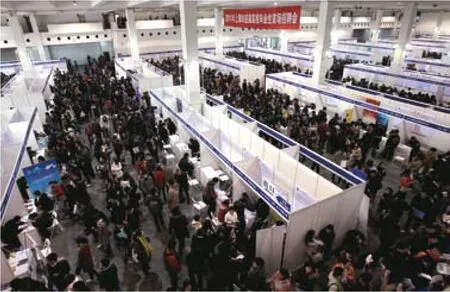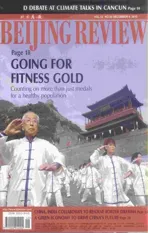MARKET WATCH
2010-10-14ByHUYUE
By HU YUE
MARKET WATCH
By HU YUE
TO THE POINT: China has toppled the United States from its decadeslong position as the world’s largest auto market for the second consecutive year. New yuan-denominated loans, totaling 7.95 trillion yuan ($1.2 trillion) in 2010, indicate mounting in fl ationary pressures. China’s foreign trade recoups strength, with both imports and exports hitting record highs in December 2010.Chinese steelmakers reel from skyrocketing iron ore prices. The Purchasing Managers Index for the non-manufacturing sector rebounds as the service sector picks up steam.
Hot Wheels
China retained its crown as the world’s top auto market by selling a record number of vehicles in 2010.
Vehicle sales across the nation grew a robust 17.9 percent in December 2010 from a year ago to reach 1.67 million units,said the China Association of Automobile Manufacturers (CAAM). The December fi gure brought the amount for the entire year to 18.06 million units, up 32.37 percent year on year.
Such euphoria has kept China in the spotlight on a dim global automobile landscape. The U.S. market regained some of its lost ground, with sales rebounding to 11.5 million for 2010, but still well below the precrisis level of more than 16 million.
While cheering about the auto euphoria,analysts are wondering how much longer the good times could possibly continue since the government has rolled back some policy incentives, including a favorable purchase tax for smaller cars, subsidies to rural buyers and an old car replacement program.
Besides this, Beijing’s latest decision to issue a limited number of new license plates this year may also take some steam out of the market, and more cities are expected to follow suit.
After a year of turbo-charged growth,the auto boom is about to take a breath, with growth dipping to less than 15 percent, said Dong Yang, Secretary General of CAAM.
The generous incentives have brought most potential buyers to the table, leaving little room for growth this year, said Rao Da,Secretary General of the National Passenger Car Information Exchange Association.
But the slowdown will provide a catalyst for manufacturers to improve their technological expertise and product quality, he said.
Over the long term, the industry still has deep potential of growth due to low car ownership, said a recent report by the market research company Nielsen
Car owners in fi rst-tier cities like Shanghai are starting to trade up—good news for luxury models. But the real opportunity is in smaller towns where income grows fast, it said.
Lending Spree
Chinese banks granted 7.95 trillion yuan($1.2 trillion) of yuan-denominated loans in 2010, overshooting the government-set target of 7.5 trillion yuan ($1.1 trillion), said the People’s Bank of China, the central bank.The figure, however, represented a 17.1-percent drop from 2009.
The broad money supply (M2), which covers cash in circulation and all deposits,stood at 72.58 trillion yuan ($11 trillion) by the end of 2010, up 19.7 percent year on year, also topping the government’s target of 17 percent.
The lending surge was one of the triggers for runaway in fl ation that has been stretching the nerves of policy makers.
“Lending remains strong due to robust domestic demands,” said Guo Tianyong,Director of the Research Center of China’s Banking Industry under the Central University of Finance and Economics. “A number of infrastructure projects and construction of massive affordable houses are shoring up the needs for fi nancing.”
The policy makers have not set a target for new loans this year, but they are less likely to risk killing the economic growth by putting a freeze on credit expansion, said Ding Zhijie, a professor of finance at the University of International Business and Economics.
In a recent statement, the central bank vowed to keep liquidity at a reasonable level,fend off financial risks and also strengthen fi nancing support for the small and mediumsized enterprises.
Trade Hits Record High
Imports and exports both hit record highs in December 2010, with total volume reaching $295.22 billion, up 21.4 percent from the previous year, said the General Administration of Customs.
Imports soared 25.6 percent year on year to reach $141.07 billion in December. The exports added up to $154.15 billion, an increase of 17.9 percent.
The trade surplus stood at $13.08 billion,shrinking 28.9 percent from one year earlier.It was also the smallest surplus since April 2010.
A slowdown in exports was in part because of a relatively high comparison base in the same period last year, said Lu Zhengwei,chief economist at the Industrial Bank Co. Ltd.
Meanwhile, after a rush of Christmas orders, exporters have to face bleak market demands, he said.
Imports have largely held up, a reflection of vibrant domestic demands, said Lu,adding that the country is expected to further encourage imports this year to narrow the trade imbalance.
Zuo Xiaolei, chief economist at the China Galaxy Securities Co. Ltd. said the underlying growth momentum of exports remains healthy.
“But it remains to be seen how the exporters fare in 2011 given the daunting challenges including simmering trade protectionism and appreciation pressures facing the yuan,” she said.
China in 2009 replaced Germany to become the world’s largest exporter, with its foreign trade accounting for nearly 10 percent of the world’s total.
Numbers of the Week
$2.85 trillion
China’s foreign exchange reserves amounted to $2.85 trillion at the end of 2010, up 18.7 percent year on year,said the People’s Bank of China.
7.74 trillion yuan
China’s tax revenues jumped 22.64 percent from a year ago to 7.74 trillion yuan ($1.17 trillion) in 2010, said the State Administration of Taxation.

STIMULATING THE JOB MARKET: Shanghai’s first job fair in 2011 for university graduates took place on January 8, providing more than 8,000 jobs. China has vowed to shore up the employment landscape and strengthen support for university students and migrant workers
Steelmakers Struggle
Chinese steelmakers are facing some serious headwinds as costs in fl ation eats into their pro fi ts.
The profit margin of the industry was around 3.5 percent, the lowest among major industries and well below the average ratio of 6 percent for all industrial sectors, said the Ministry of Industry and Information Technology (MIIT).
Iron ore prices are spiraling out of control, putting Chinese steelmakers in a tight spot, said Luo Tiejun, Deputy Director of the Department of Raw Material Industry under the MIIT.
Global miners in 2010 enforced a new quarterly pricing system linked to the spot market. For much of the past decade, the old benchmark system of annual contracts and price negotiations largely capped iron ore prices below volatile spot prices.
In 2010, China’s iron ore imports decreased 1.4 percent from a year ago, but the total costs increased 58.4 percent, said the China Iron and Steel Association.
“The monopoly of the ‘big three’miners—Vale, BHP Billition and Rio Tinto—have sapped vitality out of China’s steel industry,” said Luo. “Now it’s necessary to seek a more reasonable pricing regime.”
But the downturn will become a powerful catalyst for the country to consolidate the highly fragmented industry and boost output of more advanced products, he said.
Efforts to upgrade the industry are already underway. The Jiangsu Shagang Group, for example, in October 2010 inked an agreement with South Korea’s Pohang Iron and Steel Co. to build a joint venture in China. The tie-up would give Shagang access to the edge-cutting Finex iron-making technology, which could effectively reduce costs and pollution.
Service Sector Surges
The Purchasing Managers Index (PMI)for the non-manufacturing sector rose to 56.5 percent in December 2010, rebounding from a nine-month low of 53.2 percent in November, said the China Federation of Logistics and Purchasing (CFLP).
The index provides a snapshot of the business climate in the service sector and other non-manufacturing businesses. A reading above 50 percent indicates economic expansion.
Because of the New Year holiday,as well as the upcoming Spring Festival,which falls in early February this year, the consumer service sector, especially the retailing and catering businesses, are bursting with vitality, said Cai Jin, Deputy Director of the CFLP.
Meanwhile, the information service industry is also holding up well, making signi fi cant contributions to the PMI growth, he said.
But not every sector was faring well—the readings for hotels and air transport industries were under 50 percent.
Service business buoyancy is a needed boon for China, which is geared up to rebalance the economy to rely more on domestic demands. The tertiary industry now accounts for 42 percent of the Chinese economy, compared with nearly 90 percent in the United States.
In 2011, the government will put in place a series of favorable policies to stimulate modern service sectors, including information technology, e-commerce, and logistics,said Li Yizhong, former MIIT Minister.
